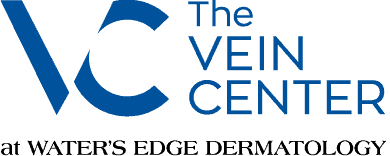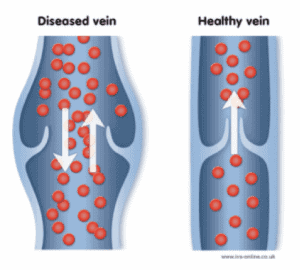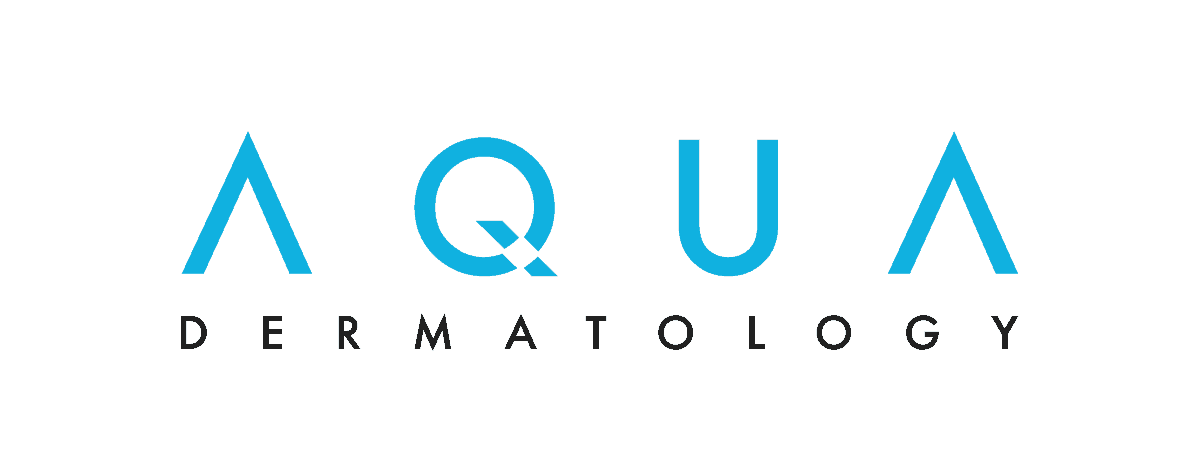Leg Veins
Call (877) 900-3223
Veins in Legs
How Leg Veins Work
Common Signs & Symptoms of Vein Disease
Stages of Vein Disease
Common Leg Vein Conditions
Leg Vein Treatments
Other Treatments
How Leg Veins Work
Because you do not have a heart in your foot to pump blood up to your chest, veins have the difficult task of moving blood from your feet and legs up to your chest against gravity and distance. This is done with what is termed a calf muscle pump and one-way valves. As you move your legs, veins are compressed by muscles and blood moves up to the heart via the one-way valves in the veins. When the one-way valves are damaged, the blood moves in both directions (up and down) which causes abnormal pressures (venous hypertension) and symptoms such as leg pain, swelling, itching, cramping, heaviness, fatigue, discomfort and restless legs. The abnormal pressures can also cause varicose veins, spider veins, ulcers and skin discoloration and thickening. Symptoms can worsen over time if left untreated.
Common Signs and Symptoms of Vein Disease
Superficial venous reflux develops when the vein valves that keep blood flowing out of your legs and back to your heart become damaged or diseased. This can cause blood to gather in your legs and result in dilated or varicose veins.
The following are common signs and symptoms of superficial venous reflux in your legs:
- Varicose veins
- Leg or ankle swelling
- Leg ulcers
- Heaviness and fatigue in your legs
- Leg pain, aching or cramping
- Burning or itching of the skin
- Restless legs
- Skin changes on your legs
This condition is progressive and if left untreated may worsen over time. If you are experiencing any of the symptoms above, it is time to have your legs examined by a vein specialist.
Back to top
Stages of Vein Disease
Chronic venous insufficiency (CVI) can develop at any age, but advanced age is a risk factor. CVI also tends to be more prevalent in people who:
- Have a family history
- Work jobs that require them to spend a great deal of time standing or sitting
- Travel long distance frequently
- Have been pregnant
- Lack exercise or are overweight
- Had previous surgery/trauma or blood clots
FIVE EASY STEPS TO KEEPING YOUR LEGS HEALTHY
- Avoid standing or sitting for long periods of time
- Elevate your legs
- Exercise regularly
- Manage your weight
- Wear graduated compression socks and stockings
Common Leg Vein Conditions
Our board-certified vein experts diagnose and treat every vein condition to alleviate symptoms involving the legs, hands, face and other parts of the body. These include:
Our vein experts have successfully and safely treated thousands of patients, even patients who have failed treatments at other facilities. In fact, we specialize in helping patients who have been misdiagnosed or received ineffective treatments elsewhere.
Leg Vein Treatments
Procedures to treat vein disorders including spider veins, varicose veins and leg ulcers have come a long way. In fact, advanced techniques to treat leg and vein issues no longer require surgical removal or “stripping” of the diseased vein from the leg.
During your first appointment at The Vein Center, a vein specialist performs a physical exam and an ultrasound of your veins and arteries – and sometimes the heart. Your physician then develops a treatment plan to address your specific vein issue(s) utilizing the most advanced and minimally invasive vein treatments available.
Your vein doctor discusses the recommended treatment plan with you and answers any questions you have. Once approved, your appointments are scheduled directly at our office where all procedures are performed. Because our vein treatment protocols do not require sedation or general anesthesia, you can resume normal activities right after your procedure.
Our state-of-the-art vein treatment options include:
Treatments for Venous Reflux / Chronic Venous Insufficiency
- Compression Therapy
- Radiofrequency Ablation (RFA) with Venefit™
- Endovenous Laser Treatment (EVLT) with Dornier Medilas D FlexiPulse 940
- ClariVein® IC
- VenaSeal™
- Varithena®
- Ultrasound-Guided Foam Sclerotherapy (UGS)
- Veinlite®
COMPRESSION THERAPY
This is a temporary, first-line therapy for venous reflux and vein disorders. This therapy is often used for vein disorders and as a preventative measure. Many athletes wear compression garments to gain a competitive edge. At The Vein Center, most of our practitioners and staff wear compression garments daily. Ask and you will be surprised when they show you the new, brightly colored compression sleeves, socks and stockings they are wearing.
RADIOFREQUENCY ABLATION (RFA) WITH VENEFIT™
The Venefit procedure uses radiofrequency energy to precisely and effectively treat chronic venous insufficiency (CVI). This procedure results in less pain and bruising than alternative treatments.
ENDOVENOUS LASER TREATMENT (EVLT) WITH DORNIER MEDILAS D FLEXIPULSE 940
Endovenous laser treatment uses laser energy to close and seal faulty veins. The body responds by automatically re-routing blood flow to surrounding healthy veins. This minimally invasive procedure requires no anesthesia and results in less pain and quicker recovery time.
CLARIVEIN® IC
The ClariVein IC is a minimally invasive procedure for treating varicose veins. During this procedure, a catheter is inserted into the faulty vein and its rotating wire tip then disperses a sclerosant solution to close the vein. No anesthesia is required and there is minimal downtime or pain involved.
VENASEAL™
This procedure actually glues the vein shut. Using ultrasound guidance, a catheter is inserted into specific areas along the diseased vein to deliver small amounts of a medical adhesive. There is very little pain or bruising and you can return to normal activity immediately following the procedure.
VARITHENA®
Varithena is a sclerosant foam that is used to close a vein. The Varithena microfoam is injected into the targeted section of the vein and treats the vein wall, which causes the diseased vein to collapse. The body automatically begins to redirect blood flow to surrounding healthy veins. The microfoam then disperses as it comes into contact with blood in the healthy veins.
ULTRASOUND-GUIDED FOAM SCLEROTHERAPY (UGS)
This is an additional procedure recommended to patients with venous reflux who also have varicose/spider veins. Once the refluxing vein is closed, the vein branches that drain to the now closed vein have to be closed. This is necessary for two reasons: (1) to decrease the chances of recurrence and future problems; (2) to help eliminate the varicose and spider veins and their symptoms.
VEINLITE®
Veinlite utilizes a surface light to see abnormal varicose veins under the skin and then close them using foam sclerotherapy. These veins often cannot be seen on the skin with the naked eye, and because they are smaller and very close to the skin surface, they are not seen well with ultrasound-guided foam sclerotherapy.
Treatments for Varicose Veins and Spider Veins
- Microphlebectomy
- Visual Foam Sclerotherapy
- Skin Laser Treatment with Dornier Medilas D FlexiPulse 940
- VeinGogh® Ohmic Thermolysis
- Veinlite®
MICROPHLEBECTOMY
Microphlebectomy is a minimally invasive surgical technique for removing large varicose veins using local anesthetic only. The procedure is painless and, once completed, the patient is able to resume normal activity immediately. The incisions are pin-sized, so no stitches are required and, as such, there is no scarring.
Some physicians feel this is an old technique for treating varicose veins. In our opinion, it is a treatment option that we offer some patients, when appropriate. As one of the most technically difficult procedures we perform at The Vein Center, it is understandable why most physicians do not offer this service. However, when in the hands of a well-trained, highly experienced vein physician, this technique has amazing medical and cosmetic results that cannot be obtained with other treatment methods.
VISUAL FOAM SCLEROTHERAPY
Foam sclerotherapy involves injecting a foam sclerosant into spider veins to cause them to close down and disappear. Once the foam destroys the inner cell lining of the spider vein, the vein shuts down and the body reabsorbs it naturally. The procedure is quick and painless.
SKIN LASER TREATMENT WITH DORNIER MEDILAS D FLEXIPULSE 940
With skin laser treatment, the laser is applied to the outside of your skin to treat spider veins just under the skin’s surface. Skin laser treatment may be used on the legs, face and body.
VEINGOGH® (OHMIC THERMOLYSIS)
Ohmic Thermolysis treats surface spider veins and tangled, thread-like veins known as telangiectasia on the legs, face and body. The VeinGogh system uses a pen-like stylus with a hair-thin needle to deliver microbursts of controlled energy just beneath the skin but above the vein. The pulses of energy heat the vein wall, causing it to collapse.
VEINLITE®
Veinlite utilizes a surface light to see abnormal varicose veins underneath the skin and close them using foam sclerotherapy. These veins typically cannot be seen with the naked eye; and because they are smaller and very close to the skin surface, they are not seen well with ultrasound-guided foam sclerotherapy.
Back to top
TREATMENTS FOR DEEP VEIN THROMBOSIS / BLOOD CLOTS
- Intravascular Ultrasound (IVUS)
- Vein Stent and Angioplasty
INTRAVASCULAR ULTRASOUND (IVUS)
The video below shows an example of an IVUS procedure. Although the video shows a procedure with an artery, the same technology is available to evaluate veins in the legs, pelvis and abdomen.
VEIN STENT AND ANGIOPLASTY
If an abnormality of the vein is identified using IVUS, the treatment is angioplasty (opening the diseased vein with a pressure balloon) and placement of a vein stent. This video demonstrates both procedures.
Treatments for Venous Ulcers
A relatively new technique for healing newly formed venous ulcers, the percutaneous Terminal Interruption of Reflux Source (TIRS) procedure reduces venous hypertension by injecting foam into the veins in the ulcer area. This allows the venous ulcer to heal rapidly. The average time for an ulcer to heal is six to eight weeks. Reducing the pressure in the veins, elevating the leg and keeping the ulcer clean and dry are crucial to preventing recurrence of venous ulcers. Wearing compression stockings or leg wraps also help reduce the pressure. Your Vein Center provider will determine the type of dressing to use on your ulcer.
Other Treatments
VASCULERA®
The diosmin in Vasculera (diosmiplex) is a molecule used to manage complications of vein disease. Diosmin is a naturally occurring flavonoid that can be isolated from food sources (such as citrus) or derived from a related flavonoid called hesperidin, which is found primarily in oranges.
DERMAKA
Dermaka is an all-natural, plant-based cream enriched with vitamins that can be used on all types of skin disorders secondary to invasive procedures including post-phlebectomy, sclerotherapy, chemical peels and laser peels. It also has anti-inflammatory, antimicrobial and antioxidant properties. Clinical testing has shown Dermaka to show rapid resolution of inflammatory changes and bruising.
If you are experiencing any issues with your legs and would like to be examined by a vein specialist, call (877) 900-3223 today to schedule your consultation.







